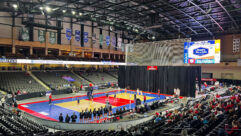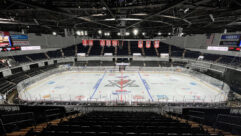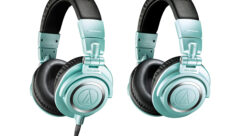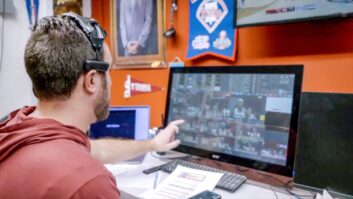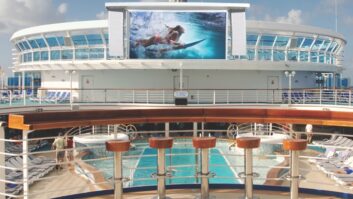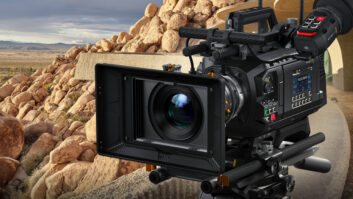Control on ice
Jan 1, 2000 12:00 PM,
Bruce Borgerson
Audio systems at a new sports/wellness complex in Denver benefit frominnovative loudspeaker cluster design and user-friendly computer control.
The University of Denver’s new $70 million sports and wellness complex hasproven a most welcome addition to campus life. In particular, the gleamingnew hockey arena, the centerpiece of the complex, was long overdue. From1947 to 1996, the school’s Pioneer hockey teams played their home games ina war surplus aircraft hanger that had been hauled piecemeal to Denver froma decommissioned naval base in Idaho. That veteran venue offered a rink,about 4,000 seats, a hodge-podge of audio equipment accumulated over thedecades and little else. In recent years, as the Pioneers moved up in thenational NCAA Division I rankings, university officials and alumni becameincreasingly frustrated with the WWII-era hangar. It had to go, and thebuilding was scheduled for demolition.
After demolition crews cleared the site, the university launched the singlemost ambitious construction project in its 133-year history-the Daniel L.Ritchie Center for Sports and Wellness. The new construction covers morethan 400,000 ft superscript 2 (37,000 m superscript 2) and encompasses theshowcase Magness Arena along with the Hamilton Gymnasium, El PomarNatatorium, Joy Burns Community/Practice Rink and Coors Fitness Center.Also integrated into the new complex were two existing facilities-theStapleton Tennis Pavilion and the Gates Field House. In addition toproviding first-class facilities for the university’s 19 NCAA Division Iteams, the Center is open to the Denver community and currently hosts morethan 30 youth and adult recreation programs.
Architects for the Center’s new construction were the Davis Partnership andSink, Combs, Dethlefs. Acoustic design and original audio systemspecifications were assigned to Boner Associates, Austin, TX, and adesign-build contract for all new audio systems in the complex was awardedto Electromedia, Arvada, CO.
NHL impact, collegiate budget
The Magness Arena seats 6,200 in theater-style seats for hockey games,7,200 for basketball and more than 8,000 in concert seating configurations.It shares many spectator-friendly characteristics common to other newerfacilities, including steeply raked seating areas for a feeling ofintimacy, clear sightlines from all seats and a state-of-the-art audiosystem. Delivering quality audio in the venue, however, proved to be achallenge because of the hard reflective surfaces (steel, ice and hardseats) and a relatively low ceiling with a high scoreboard hang. Also,although adequate, the budget left no room for over-engineering to be onthe safe side in terms of SPL. Unlike professional sports arenas into whichteams often pour in millions for glitzy sportainment effects, collegiatefacilities face much tighter budget constraints when it comes to A-Vsystems. This puts the squeeze on system designers because collegiate fansalso have come to expect a high-impact, music- and effects-laden experience.
“With the original budget as submitted to the consultant, we could havecome close to an NHL-class system,” said Electromedia Senior Engineer MarkGraham, the system’s primary designer, “but when all bids came in high forthe basic iron and cement type of work, the audio budget was cut backsubstantially. We had to do some basic value engineering. We had to do awaywith bells and whistles and focus on getting good coverage at respectablevolume. We couldn’t do the 110 dB peaks of new pro arenas, but we set agoal in the upper 90s in nearly all seats with a -6 dB point at about 45Hz.”
The consultant’s original specification called for an extensive distributedsystem, which would have produced superb results, according to Graham, butwith the lower overall budget, Electromedia had to find some way to getsubstantially equivalent results using fewer loudspeaker cluster locations.
Icing boom buildup
Fewer clusters cut costs, but making them run at higher levels and throwfurther raised potential problems with inconsistent mid-high coverage aswell as bass buildup, the nemesis of modern, full-range arena systems.Scoreboard sightlines imposed further restrictions because loudspeakerclusters could not hang more than approximately 4 feet (1.2 m) below thelowest red iron beams. Essentially, Graham set out to create a design thatcould fill the room, maintain broad bandwidth pattern control (preferablyto 100 Hz and below) and do it all with only eight clusters, each no morethan about 4 feet high.
“My starting point was to get some vertical control of the lowfrequencies,” said Graham, “because the room has a pretty nasty reverb timearound 100 Hz, over four seconds. The classic way to deal with this problemis with a horizontal line array, but we didn’t have enough height allowanceto do it in a straight line. So we used two custom JBL three-way cabinetsin a horizontal array with dual 14 inch (357 mm) low-frequency drivers ineach box. As installed, with the two boxes angled down at 15 degrees and 50degrees, the four drivers line up to form a curved vertical line array. Ineach cluster, the top and bottom bass drivers take a common feed off oneoutput of the Peavey MediaMatrix, and the two middle loudspeakers are fedfrom another output. So, by introducing small amounts of delay on the ends,we can use beam steering to generate about 100 degrees of vertical patterncontrol. That helps the system maintain relatively flat, defined bass inthe audience area without overloading the room.”
The loudspeaker cabinets were designed by Andrew Rutkin, director of customproduct engineering at JBL, following Graham’s concept and performancespecifications.
“What we created is essentially a two-box system made up of a widehorizontal coverage module and a narrow coverage module,” said Rutkin. “Thetop module has 60 degree horizontal mid- and high-frequency horns for thelonger throw to the top seats, and the bottom module has a 90 degreepattern to cover the lower seats close underneath. The horn-loaded 10 inch(254 mm) mid-range drivers are interesting in that they are symmetricalhorizontally but asymmetrical vertically, so when stacked at the propersplay angle, they couple to create a symmetrical vertical pattern. They have a practically coincident point of origin in this frequency band because thetwo drivers have only the cabinet thickness between them.”
The result of this collaboration is an innovative cluster design uniquelysuited to arena applications. “When you project this cluster’s coverage onthe typical seating area,” said Rutkin, “you get more of a rectangularshape, not the pie shape typical of single pattern clusters. This makes itmuch easier to eliminate hot spots and dead spots when covering adjacentseating areas.”
Rutkin says that the cluster modules are not currently in the JBL productline, but they can be supplied by the JBL Custom Shop as models CSM4364H(60 degrees) and CSM4395H (90 degrees) on only a few weeks’ notice becausemajor components are identical to those in JBL’s current Venue seriesproduct.
The completed Magness system uses seven of the dual-box line array clusterswith four additional single cabinets employed at the north end where severeheight restrictions (due to concert rigging steelwork) did not allowtwo-high clusters. Eight additional high- frequency hockey horns (JBL 2447Hdriver/2353 60 degrees infinity 40 degrees horn) are aimed straight down toprovide high frequency fill to shadowed seats immediately behind thePlexiglass dasher boards. Six JBL Sound Power SP212A cabinets, hung fromthe scoreboard, cover the playing surface with the high-level,music-quality reproduction needed for such events as figure skatingcompetitions. All arena loudspeakers are powered by a complement of 22 QSCMX3000a, MX2000a and MX700 amps.
MediaMatrix control
Like many other multi-use facilities, the Magness Arena uses a PeaveyMediaMatrix system for general signal processing and electronicreconfiguration to accommodate different events. In this installation,Graham chose a MiniFrame 208 with four bobs for a maximum 32infinity32in/out capacity.
“We’re using the MediaMatrix for all our drive processing, cluster delaysand output matrixing,” Graham said, “so we have it pretty much maxed out.We used very few outboard boxes for some miscellaneous needs, such as aPeavey IDL1000 delay for the JBL Control 5 control room monitors to getthem in sync with the main clusters.”
The MediaMatrix system is pre-programmed with presets for all common uses,including hockey, basketball and special events. In the latterconfiguration, middle- and south-end clusters are delayed, referenced to azero point at the north end stage location. Also, a bitmap screen graphicallows operators to turn individual clusters on and off within a preset bymouse-clicking on cluster icons. The primary use of this feature, saidGraham, is to turn off clusters over empty seating areas during events withlimited attendance. Electromedia Associate Engineer Josh Beaudoin devotedthe better part of three days to the design an attractive interface screenthat would be as simple to use as possible.
“You have to plan for those times when a regular operator calls in sick andsome substitute comes in,” Beaudoin said. “We imported a bitmap of thearena layout, but it doesn’t have a lot of detail, so we had to be verycareful about color selection and color balancing so that the operator cantell immediately which buttons affect which areas of the arena.”
Flexible support systems
To accommodate a wide variety of possible uses, Electromedia installed anextensive network of tie lines and provided dual split boxes to accommodatebroadcast requirements. A 16infinity4 multipin connector is located at bothcenter ice and at the stage end, which connects to a supplied snake forrunning out to a video truck at the dock.
“That facility will take care of multiple mic feeds for a network-typeproduction,” said Graham, “but we also have eight permanent tie lines tothe dock for less demanding requirements. Again, it’s a matter of valueengineering. Using the snake takes care of an infrequent requirement at afraction of the cost of installing a permanent split and much biggerpatchbays.”
In the sound booth, front-end equipment includes a 24-input Yamaha GF-24console. In addition to 24 mic level patch points, signal inputs to theYamaha include two Sony UHF wireless mics, a Tascam cassette deck andTascam CD player. A patchable Symetrix 528E voice processor is provided forthe announcing mic, a headworn Crown CM311. Incidental music and soundeffects come from a laptop computer not supplied as part of the contract.
To meet assisted listening requirements, Electromedia installed a PhonicEar 550T with a remote antenna installed over center ice. Productionintercom needs are fulfilled by a two-channel Clear-Com wired system with15 remote stations, supplemented by a wireless Clear-Com system.
“Wireless systems are much more expensive,” said Graham, “but using themavoided running lines at the spectator level and also gave us a portablesystem for the adjacent gymnasium where there was no budget for anyintercom at all.”
The Magness Arena system was commissioned a few hours before the Pioneerhockey team’s home opener for the 1999 season. Mark Graham admits to beingsomewhat apprehensive about the system’s performance, but after a few hoursof system tuning using a SMAART system, his fears were allayed. The curvedline arrays seemed to be behaving exactly as predicted in the EASE modeling.
“We were able to get a clean, punchy bass,” Graham said. “The system isamazingly musical considering the surroundings, and we have excellentintelligibility at all seats.”
A wired complex
Although the Magness Arena showcases the most innovations (and consumed themajority of the budget), Electromedia also supplied audio systems for thecomplex’s new gymnasium, natatorium, fitness center and alumnilounge/meeting room. The Hamilton Gymnasium was particularly challenging,again because of budget restrictions. Not willing to compromise basicquality, Graham designed a high-quality system to cover all seating areasusing six JBL Sound Power SP222 two-way cabinets with two additionalcabinets covering the floor area. All operate with passive crossover withone channel of a QSC MX2000A amp assigned to each. Zoning control ishandled by a Peavey MediaMatrix X-Frame in conjunction with a custompushbutton panel, which allows selection of “Game” or “Stage” presets alongwith individual muting of bleacher areas and floor systems. For mosttypical uses, mics connect via permanent input panels to a Peavey A/A-8Ppreamp and auto mixer. For special events, an X-Frame preset selects aMackie 1604VLZ mixer with inputs normalled to a 16-channel multipin snakeconnector. To prepare for future needs while holding to current budget,Electromedia ran cable for a second floor box as well as for recommendedJBL SP212 loudspeakers to cover the upper concourses, but neither wereincluded in the first-round installation.
In the Coors Fitness Center, the weight room keeps them pumping with 16 JBLControl 26CT two-way ceiling loudspeakers, augmented by six Control 19CSTceiling subwoofers. Sources for the EVI Audio ELX-1A mixer include a TOAAM/FM tuner, Marantz CD/cassette combo, and custom mic/line input panel.Power is supplied by a QSC CX-6T amp. The dance and aerobics rooms are eachequipped with seven of the JBL Control 26CT two-way speakers and threeControl 19CST subwoofers. For these rooms, all other equipment (save theautomatic fire override system) is contained in a roll-around rack. Eachrack contains the same mixer and CD/tape units as the weight room but alsooffers a Sony WRR800 UHF wireless receiver and Shure DFR11 feedbackcontroller. Power comes from a QSC MX1500a amp. Three of these racks wereprovided in the contract because they can also connect to existing orproposed systems in the practice ice rink, tennis pavilion and field house.
Finally, there is a particularly pleasant system for those folks who wereinstrumental in making it all happen-the alumni. The Pioneer Room systemuses an Ivie 784 mixer to select from the available sources:audio-from-video, TOA AM/FM tuner, Marantz CD changer or mic inputs. Thesound comes out through 11 JBL Control 26CT, seven Control 24CT and four Control 19CST subs, the entire contingent is powered by a pair of QSC 302V amps.
According to Graham, the overall Ritchie Center installation proceededsmoothly and involved (in his words) “nothing particularly new or unusual.”Nevertheless, he suspected that the innovative cluster co-developed withJBL marks an incremental step forward in engineering cost-efficient,high-level arena systems.
“The concepts behind it are well known,” he said, “but we may have come upwith a new wrinkle in this particular cabinet configuration. It will beinteresting to see if this particular approach finds wider application inother similar systems in the future.”


